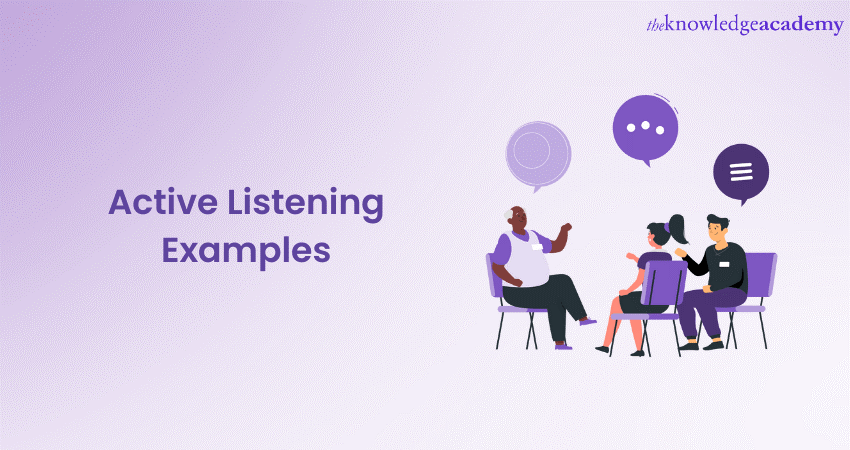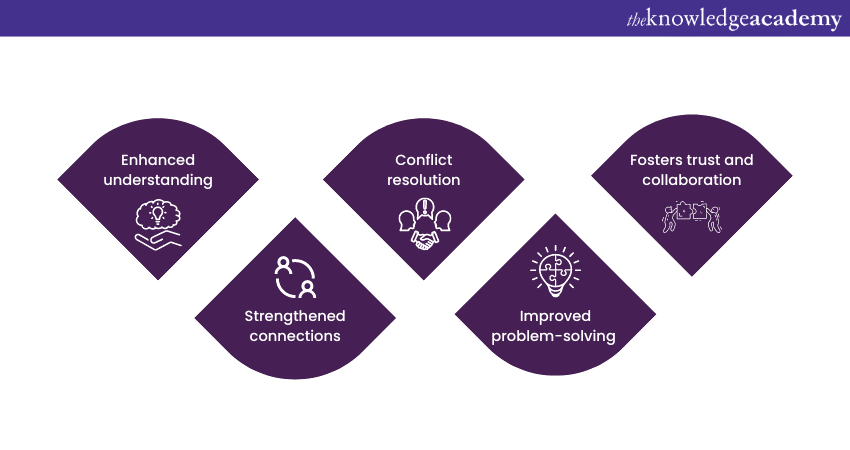We may not have the course you’re looking for. If you enquire or give us a call on +0800 780004 and speak to our training experts, we may still be able to help with your training requirements.
Training Outcomes Within Your Budget!
We ensure quality, budget-alignment, and timely delivery by our expert instructors.

Effective communication is essential for successful relationships, be it in personal connections or the professional domain. At the heart of successful communication lies the priceless skill of Active Listening. Understanding Active Listening Examples can lead to more meaningful interactions and stronger connections with others.
According to Talent.com, the average salary of a Communication Specialist in the UK is £37,074 per year. Developing communication skills like Active Listening is crucial, be it Communication Specialist or any role. In this blog, you will understand Active Listening and Active Listening Examples in detail. Let’s dive in deeper to learn more!
Table of Contents
1) Understanding Active Listening
2) The 12 Active Listening Examples
a) Empathetic responses
b) Reflective responses
c) Open-ended questions
d) Avoiding interruptions
e) Maintain eye contact
f) Minimise distractions
g) Positive body language
h) Stay non-judgmental
i) Improving Leadership Skills
j) Conflict resolution
k) Caring and understanding
l) Building trust
3) Conclusion
Understanding Active Listening
Active Listening refers to the practice of fully concentrating, understanding, responding, and remembering what the speaker is saying. It involves being present at the moment and actively engaging with the speaker to grasp not just the words but also the emotions and intentions behind the message.
By understanding What is Active Listening Examples, you can gain practical insights into how to apply this skill in various situations.

The 12 Active Listening Examples
Active Listening is a crucial skill that plays a pivotal role in encouraging meaningful connections with others. When we engage in Active Listening, we demonstrate genuine interest and understanding of what the speaker is conveying. Let’s explore some examples of Active Listening:

Empathetic responses
When a friend shares their excitement about a recent accomplishment, respond with genuine enthusiasm and congratulate them on their achievement. Show that you understand how important this moment is for them. Let's take a look at an example of empathetic responses:
1) Friend: "I finally got that promotion I've been working so hard for!"
2) Active Listening response: "That's fantastic news! I can understand how proud and excited you must feel right now. Congratulations on your well-deserved promotion!"
Reflective responses
During a heated discussion with a colleague, try to understand their viewpoint by repeating their main arguments in your own words. This demonstrates that you are actively listening and seeking to comprehend their perspective. Let's see an example of reflective responses:
1) Colleague: "I think our team should focus on expanding our marketing efforts."
2) Active Listening response: "So, you're suggesting that our team should put more emphasis on marketing to reach a broader audience, correct?"
Elevate your decision-making and embrace success with our Strategic Planning And Thinking Training. Sign up now!
Open-ended questions
When talking to a family member who seems upset, ask questions that allow them to express their feelings fully. For instance, inquire, "How did that situation make you feel?" or "What do you think could have been done differently?" Here's an example of open-ended questions:
1) Family member: "I'm really frustrated with my workload at the moment."
2) Active Listening response: "I'm here for you. Can you tell me more about what's causing you to feel overwhelmed with your workload?"
Avoiding interruptions
While having a conversation with your partner, refrain from interrupting them, even if you disagree. Let them finish expressing their thoughts before sharing your opinion. Here's an example of avoiding interruptions:
1) Partner: "I think we should consider redecorating the living room."
2) Active Listening response: "I hear your idea about redecorating the living room. Kindly proceed to express your opinions about how you envision it."
Maintain eye contact
When speaking with a client or customer, try to maintain eye contact to show that you are attentive and focused on their needs. This non-verbal cue conveys respect and interest in what they have to say. Let's look at an example of maintaining eye contact:
1) Client: "I have some concerns about the project's timeline."
2) Active Listening response: (Maintaining eye contact) "Thank you for bringing this up. Please share your concerns, and I'll do my best to address them."
Minimise distractions
During a team meeting, put away your phone and close unnecessary tabs on your computer. Give your full attention to the speaker, promoting a productive and focused discussion. Here's an example of minimising distractions:
1) Team member: "I have an idea for a new product feature."
2) Active Listening response: (Closing unnecessary tabs) "I'm all ears. Please go ahead and share your idea for the new product feature."
Positive body language
Attending a friend's presentation, nod and smile to show that you are engaged and supportive of their efforts. Positive body language encourages them to continue with confidence. Let's see an example of positive body language:
1) Friend: "I'm thinking of starting my own business."
2) Active Listening response: (Nodding and smiling) "That's exciting! I believe you have the skills and determination to make it a success. Tell me more about your business idea."
Stay non-judgmental
Avoid making assumptions or judgments while listening. Let the speaker express themselves without fear of criticism. Here's an example of staying non-judgmental:
1) Family member: "I made a big mistake at work today."
2) Active Listening response: "Everyone makes mistakes sometimes. I'm here to listen and support you. Take your time and share what happened."
Improving Leadership Skills
As a manager, practice Active Listening during one-on-one meetings with your team members. Pay attention to their concerns, ideas, and feedback to strengthen your leadership skills. Let's look at an example of improving leadership skills:
1) Team member: "I have some concerns about the project's direction."
2) Active Listening response: "I value your feedback. Let's discuss your concerns further, and I'll consider how we can address them in the project plan."
Conflict resolution
In a team setting, practice Active Listening during discussions to understand the various viewpoints. This can lead to finding common ground and resolving conflicts more effectively. Let's see an example of conflict resolution:
1) Team member A: "I think we should focus on increasing our marketing efforts."
2) Team member B: "I disagree; we should prioritise improving our product quality."
Active Listening response: "I hear both of your perspectives. Let's explore the benefits of each approach and find a solution that balances both marketing and product improvements."
Caring and understanding
Active Listening is a key aspect of emotional intelligence, as it enables us to understand and relate to the emotions of others. This fosters empathy, a critical component of emotional intelligence. Here's an example of empathy and understanding:
1) Friend: "I'm feeling really stressed about upcoming exams."
2) Active Listening response: "I understand how challenging it can be to prepare for exams. Is there anything specific you would like to talk about or any support you need?"
Building trust
Trust is the bedrock of each and every successful relationship. Through Active Listening, we demonstrate our trustworthiness by valuing and respecting the thoughts and feelings of others. Let's see an example of building trust:
1) Partner: "I'm feeling uncertain about my career decisions."
2) Active Listening response: "I appreciate your honesty. I'm here to support you in any way I can. We'll work through this together and find the best path forward."
By incorporating these Active Listening techniques into your conversations, you can enhance your communication skills, deepen your connections with others, and foster a more empathetic and understanding environment in both your personal and professional life.
Amplify your communication impact with our Active Listening Skills Training. Sign up today!
Conclusion
We hope you read and understand Active Listening Examples. Active Listening is an extremely powerful tool for communication. By empathetically responding, using reflective techniques, and asking open-ended questions, we can build deeper connections. This will help enhance our relationships both personally and professionally.
Unlock your true potential with our Personal Development Training Courses. Sign up now!
Frequently Asked Questions
Upcoming Business Skills Resources Batches & Dates
Date
 Active Listening Training
Active Listening Training
Fri 31st Jan 2025
Fri 21st Mar 2025
Fri 30th May 2025
Fri 18th Jul 2025
Fri 19th Sep 2025
Fri 21st Nov 2025







 Top Rated Course
Top Rated Course


 If you wish to make any changes to your course, please
If you wish to make any changes to your course, please


